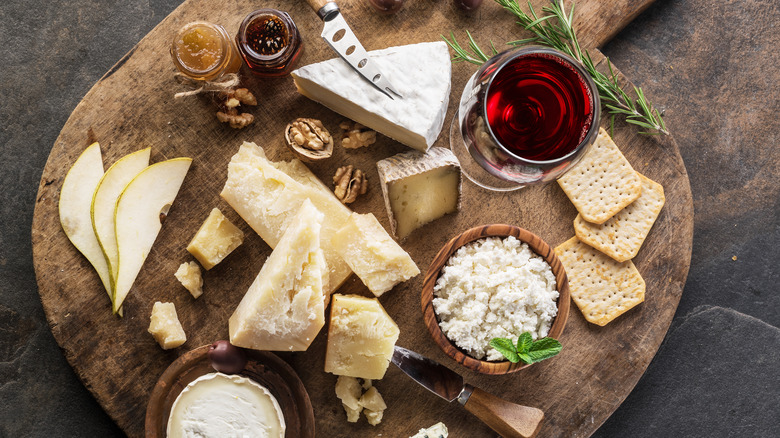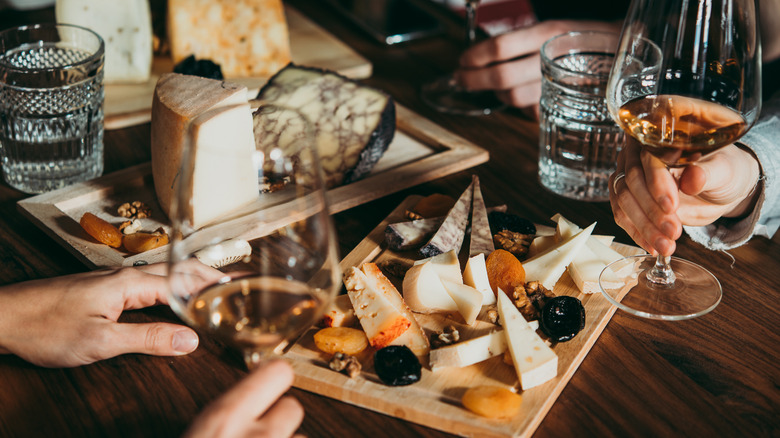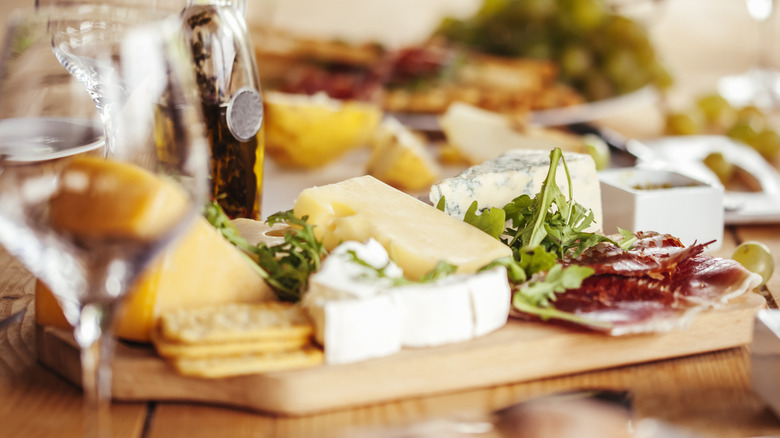The Cheese Rule To Follow If You Want To Dine Like The French On Your Next Trip
Close your eyes and imagine a quaint French restaurant on a side street somewhere in Marseille. You've ordered your favorite main course, flambéed of course, and now it's time for dessert. As you eagerly anticipate the sweet finale, the waiter appears with a tray of fragrant cheese. Wait, what? Cheese before dessert?
Welcome to the world of French dining. The confusion is understandable, as charcuterie boards have recently exploded in popularity in the United States. Often displayed as a shared plate, the board usually contains a variety of cured meats, fruits, nuts, crackers, and cheese that is served as an appetizer. But for the French, cheese isn't just a mere prelude to the main course. Au contraire, dear friend, the cheese course comes at the end of the meal, something salé before the sucré.
The French have made an art form of indulging in their cheese — from creamy Brie de Meaux to sharp Roquefort, the cheese course is a celebration of France's rich culinary history and a nod to the art of slow food that prepares your palate for the final, sugary act. But what makes the French cheese course so special? And how can you adopt this tradition into your own dining experiences wherever you find yourself on vacation?
Why the French end their meals with a cheesy twist
To understand the pre-dessert French cheese course, it's helpful to begin with a quote from Jean Anthelme Brillat-Savarin, the famed author of "The Physiology of Taste." Writing in the circa 1825 book, he posited that "A dessert without cheese is like a beautiful woman who is missing an eye."
As evidenced by his poetic description of this French culinary treasure, cheese is more than just a mere appetizer; it's a passion, a way of life. The French understand that cheese is a complex, multifaceted food that requires the full attention of one's taste buds.
Indulging in cheese before dessert gives your palate a chance to truly appreciate each cheese's unique flavors and textures in preparation for a (typically) light dessert. Stronger cheeses, like Roquefort or bleu d'Auvergne, can be paired with sweet white wine, like a Sauternes or Sainte-Croix-du-Mont.
The flavors should balance each other out and prepare the palate for a light, refreshing dessert, such as a fruit salad, sorbet, or fresh berries. And if you really want to take it up a notch, serve sweet, fortified wine like a delicious port, Muscat de Beaumes-de-Venise, or even a glass of Commandaria, the world's oldest dessert wine.
Others suggest a more practical reason for the cheese course by arguing that you might actually be doing your body a favor by indulging in various types of fromage after the main course — cheese can aid digestion due to the presence of probiotics.
What to look for in a cheese course
Excerpts from "The Cook's Atelier" by Marjorie Taylor and Kendall Smith Franchini provide guidance on what to look for in a post-meal cheese course by noting that, while the quality and variety of cheeses matter, the board should be aesthetically pleasing, too.
They say that "When preparing our cheese board, we make sure to include a variety of types (cow's, sheep's, and goat's milk), textures, colors, and affinages (ages)." If possible, seek out unpasteurized cheese, which is untamed and full of nuance, with a flavor profile that evolves as it ages.
The goal should be to experience a variety of cheeses from different regions that can cater to different tastes and preferences. Just remember that cheese should be served at room temperature, meaning it should've been removed from the refrigerator about an hour before eating. As an eager diner ready to devour delicious cheeses before the final course, carve a slice from each cheese on the board, starting with the softest, mildest cheese and working your way to the most robust. When cutting the cheese, try to preserve the original shape.
Ultimately, each selection has a story and a distinct flavor profile, whether you're indulging in local cheeses or fromage from France like creamy Camembert and tangy Roquefort. The cheese course, therefore, serves as a chance to take your tastebuds on a tantalizing tour, no matter where you take your next trip.


